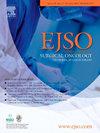Risk factors for major complications following pelvic exenteration: A NSQIP study
IF 2.9
2区 医学
Q2 ONCOLOGY
引用次数: 0
Abstract
Objectives
Due to the rarity of pelvic exenteration surgery, it is challenging to predict which patients are at an increased risk for postoperative complications. We aimed to study the predictors for postoperative complications among women undergoing pelvic exenteration for gynecologic malignancy.
Method
We used the National Surgical Quality Improvement Program registry to evaluate postoperative course and complications of those patients undergoing pelvic exenteration in the period 2012–2022. The primary objective of the analysis was to estimate the major postoperative complications following pelvic exenteration.
Results
Overall, 794 pelvic exenterations were included. Of those, 56.5 % were anterior exenteration, 43.5 % were posterior exenteration, and 13.9 % were a combined exenteration. The rate of minor complications was 72.5 % (n = 576), and the rate of major complications was 31.5 % (n = 250). The most common minor complications were blood transfusion (n = 538, 67.8 %), followed by superficial surgical site infections (SSI) and urinary tract infections (9.8 % and 9.4 %, respectively). Among the major complications, the most common was organ/space SSI (11.2 %), followed by sepsis (9.2 %), reoperation (8.6 %), and wound dehiscence (5.2 %). Death within 30 days occurred in 1.5 % of patients. In multivariable regression analysis, the following factors were independently associated with major complications: higher BMI [adjusted odds ratio (aOR) 1.03 95 % confidence interval (CI) (1.01–1.05)], diabetes [aOR 1.82 95 % CI (1.13–3.22)], low serum albumin [aOR 0.73 95 % CI (0.54–0.98)], and high serum creatinine [aOR 1.70 95 % CI (1.05–2.77)].
Conclusions
Major postoperative complications occur in approximately one third of pelvic exenterations for gynecologic malignancies. Our study highlights independent factors associated with major postoperative complications, of which some are potentially modifiable.
骨盆外展术后主要并发症的风险因素:一项 NSQIP 研究
目的由于盆腔外扩张手术的罕见性,预测哪些患者术后并发症的风险会增加具有挑战性。我们的目的是研究因妇科恶性肿瘤而接受盆腔外扩张术的女性患者术后并发症的预测因素。方法我们利用国家外科质量改进计划登记册评估了 2012-2022 年期间接受盆腔外扩张术的患者的术后病程和并发症。分析的主要目的是估计盆腔外翻术后的主要并发症。其中,56.5%为前路外展术,43.5%为后路外展术,13.9%为联合外展术。轻微并发症发生率为72.5%(576人),主要并发症发生率为31.5%(250人)。最常见的轻微并发症是输血(538 人,67.8%),其次是浅表手术部位感染(SSI)和尿路感染(分别为 9.8% 和 9.4%)。在主要并发症中,最常见的是器官/空间 SSI(11.2%),其次是败血症(9.2%)、再次手术(8.6%)和伤口开裂(5.2%)。1.5%的患者在30天内死亡。在多变量回归分析中,以下因素与主要并发症独立相关:较高的体重指数(BMI)[调整后的几率比(aOR)为 1.03,95% 置信区间(CI)为(1.01-1.05)]、糖尿病[aOR 为 1.82,95% 置信区间(CI)为(1.13-3.结论约有三分之一的妇科恶性肿瘤盆腔外切手术会出现严重的术后并发症。我们的研究强调了与主要术后并发症相关的独立因素,其中一些因素可能是可以改变的。
本文章由计算机程序翻译,如有差异,请以英文原文为准。
求助全文
约1分钟内获得全文
求助全文
来源期刊

Ejso
医学-外科
CiteScore
6.40
自引率
2.60%
发文量
1148
审稿时长
41 days
期刊介绍:
JSO - European Journal of Surgical Oncology ("the Journal of Cancer Surgery") is the Official Journal of the European Society of Surgical Oncology and BASO ~ the Association for Cancer Surgery.
The EJSO aims to advance surgical oncology research and practice through the publication of original research articles, review articles, editorials, debates and correspondence.
 求助内容:
求助内容: 应助结果提醒方式:
应助结果提醒方式:


